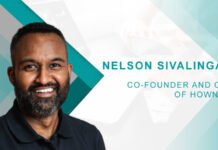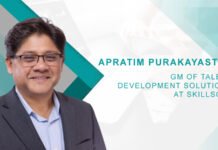HRTech products have evolved over the years giving organizations the expected transparency. Are there any more changes yet to come?
1. Tell us about your role at InStride.
As the VP, Product at InStride, I’m responsible for our product management, product design and product analytics functions to deliver on our company strategy as we champion a bold new approach to workforce education.
InStride’s platform helps to enable our three-sided market alignment, bringing together academic institutions, companies and employees through our strategic approach to each corporate partner’s needs.
2. Can you tell us about your journey into this market?
I’ve been in product for quite some time now, as a founder at early-stage start-ups in the education and healthcare space, as well as at large companies such as Disney Parks.
B2B2C experiences always resonate with me because of their complexity and opportunity to make step changes in the user experience that have big impact.
I was drawn to InStride because ofthe company’s mission. Education is a key to career and personal growth, and being responsible for building a platform to help scale our mission and impact is very rewarding.
3. How do you think technology is revamping the HR Sector?
HR teams have traditionally only had access to lackluster, non-user centered, back-office style software. The opportunity to improve the experience for the professionals in this sector is immense and many start-up companies are taking advantage of this across all major HR categories from learning and payroll, to benefits and people management.
It was only a matter of time before SaaS platforms reached this sector and we’ve seen an explosion. Since 2019, VC investment in and adoption of HR tech have grown exponentially as companies look to upgrade legacy platforms that not only improve the experience of the HR function, but also for the end users (employees). Companies realize that technology can better scale the HR function and help employees engage more with this critical part of their business.
4. What do you think is the biggest technological challenge in HRTech industry right now?
With the flood of new SaaS platforms, the challenge that HR leaders face now is figuring out the best one to choose based on how it fits into their ecosystem and meets their criteria for solving their biggest needs.
On top of that, as companies look to upgrade their legacy systems, it’s hard for them to unwind all the integrations and complex feature sets that evolved over time with those platforms. For instance, many legacy workforce education platforms can be complicated and involve a steep learning curve. InStride’s platform is built for ease of use for both employee learners and the staff that run the program. Administrators have relevant metrics at their fingertips allowing them to monitor learner progress, program usage and program spending. Without data, it’s impossible to know the impact of a program. InStride makes it simple to access this information through reports that highlight actionable data. This frees up staff time to make strategic decisions on how to maximize the benefits of InStride’s education solution for the company’s workforce.
Companies need to find the right vendor and platform to help them with these transitions, while keeping what worked and getting rid of what didn’t.
5. How can InStride assist organizations with their employee engagement needs?
An engaged workforce is key to the success and health of any company. And providing education is a proven way to drive employee engagement.
In a recent survey, 80 percent of respondents reported that learning and development opportunities would help them feel more engaged on the job. People want their employer to invest in their professional growth and development. This especially rings true now as many industries face unprecedented labor shortages and employees feel pressure to update their skill sets.
That is why InStride supports our workforce education programs with an easy-to-use platform that is intuitive and familiar, and simplifies the education process for:
- Employee-learners: The experience starts with a user-centric design that mimics daily digital habits and provides all the information they need to research available programs, apply for financial aid and enroll in classes. A pathfinder tool helps learners find the programs best suited to help them achieve their professional goals, mapping business needs and skills to specific classes and academic programs. Company-specific information about coverage, benefits and even dependent options are available 24/7.
- Corporations: InStride’s platform offers a turnkey solution for what can be an unwieldy amount of data. Program parameters are used to build a customized experience for the staff that administers these programs, offering aggregated and individual employee-learner information in actionable forms. Most importantly, corporations gain crucial insight into the success of their workforce education program. For example, this data can help administrators tell a story of success to their leadership team, so they can continue to get executive buy-in to grow and invest in the program.
6. What are the most important components of a technology platform to consider for a workforce education program?
The most important components of a technology platform include:
- User Experience: A thoughtfully designed user experience (UX) that simplifies the management of a workforce education program for administrators and streamlines the experience for employee learners.
- Personalization and Adaptation: A platform that can be adapted to meet a company’s needs, including serving as a connection between existing systems/platforms.
- Data and Insights: Tools that deliver the ROI forecasts and learner insights needed to demonstrate success.
- Culture and Brand: An interface that reflects a company voice and branding.
- Scalability: A platform that can grow with an organization.
7. Why is it important for the platform to deliver industry-leading user experiences for all audiences?
Whether it’s an HR professional or an employee using the platform, that person has built daily digital habits on products like Facebook, WhatsApp and LinkedIn that have shaped how they expect every digital experience to be. So in turn, InStride’s platform needs to be intuitive, fast and easy-to-use. That’s what end users expect, so it’s incredibly important to deliver industry-leading user experiences.
8. How do you leverage technology and tools to deliver ROI forecasts and learner insights?
We’ve really focused on making sure we have the right data to help our corporate partners tell a story, driven by ROI and learner insights. For example, early on we pushed to make sure that we had reliable data flows from our academic partners on our corporate partners’ employee-learners. Our administrator experience gives HR professionals macro-level data about how their program is performing. It also provides spend data at the program, category and learner levels, on top of all the learner-level data. That means they have easy access to see when learners are finishing up career-readiness education so administrators can pull data for internal analysis and promotion conversations.
9. What advice would you like to give to technology startups?
It’s really important to start with knowing absolutely why a company is hiring or purchasing your product, and where in the journey you’re solving their most pressing needs.
As you talk to more potential partners, launch more programs and build new features, you’ll learn a lot about what other things make sense to add into your feature-set. That experience and knowledge makes your service more robust and gives you an even stronger competitive advantage, because you can solve that many more pain points for your customers.
10. Can you tell us about your team and how it supports you?
As a product leader, my team is everyone at InStride. Yes, I have a dedicated team of product managers, designers and analytics professionals, but everyone at InStride has an enormous impact on our roadmap and what we build.
Insights from our sales team and access to customers in the pipeline help us see ahead and test new hypotheses in our strategy. The marketing team validates messaging and features in the market. The technology team ensures that we’re not building for one customer, but always thinking about how we’re scaling and creating operational excellence as we grow. The customer success and support teams provide us with real, tangible feedback from customers for existing features as well as providing audiences to provide feedback on future initiatives.
The list goes on. It takes a village to build a roadmap that our entire company believes in.
11. What movie inspires you the most?
Oddly enough, I think one of my favorite movies, My Cousin Vinny, sums up the life of a successful product person.
In the movie, Vinny is called upon by his nephew to help get him out of jail because they think he is a high-caliber attorney. Vinny clearly was not and had to really stretch himself on this new case. After numerous setbacks and learnings throughout the trial he finds “product-market-fit” for his legal capabilities by the end of the movie. His success is achieved by learning to rely on feedback, guidance and support from those around him.
This is the life of a product person. When people submit a feature request to the product team, they often assume you’ll immediately have the solution. Wrong. It takes a lot of work, iteration, learning and support from those around you to find that perfect solution. Also, it also doesn’t hurt to layer in some humor to make sure the team has some fun along the way!
12. We have heard that you have a very joyful work culture, so can you share with us some of the fun pictures of your workplace?



For more such Updates Log on to www.hrtechcube.com

Daniel Altobello VP of Product Management at InStride
Daniel Altobello is the Vice President of Product at InStride. In this role, Daniel sets the company’s product strategy and oversees product development, user experience design and analytics. Previously, he served in product/operational leadership roles at Disney Parks, Paramount Pictures and Technicolor, helping to incubate, launch and scale innovative customer experiences. He also has co-founded two B2B2C start-up companies (Tiatros and K12Complete), both of which have products still in use today. Daniel holds a bachelor’s degree in Management and Technology from Rensselaer Polytechnic Institute and a certificate in Disruptive Strategy from Harvard Business School. He has appeared as a guest lecturer at the USC Marshall School of Business on topics such as Artificial Intelligence and Physical-Digital Convergence.












